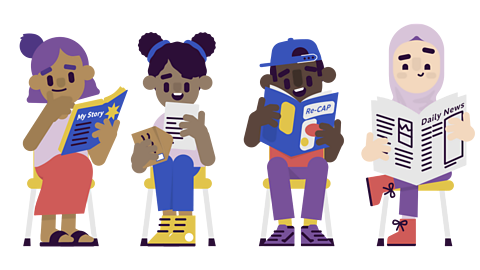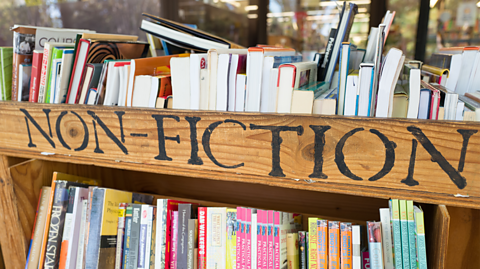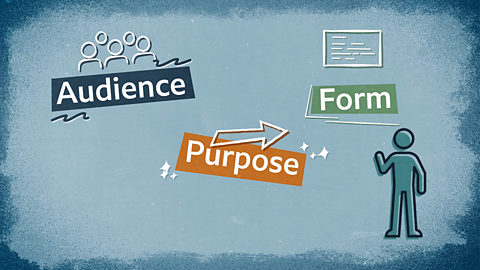Introduction to comparing non-fiction texts
- A non-fiction text is based on real-life events and issues and often contains facts and information
- Comparing non-fiction involves focusing on similarities and differences
- Comparing could focus on form, purpose, audience, language choices and structure
Different types of non-fiction text

A text is any piece of writing. A text can be labelled as either fiction or non-fiction. Fiction texts are usually based on the writer’s imagination. Novels, short stories, plays, film scripts and poetry are all examples of fiction texts. Non-fiction texts are based on facts and the real world and include:
- news articles
- magazine articles
- blogs
- speeches
- letters
- diaries
- biographies
- adverts
Looking at similarities and differences
Comparing non-fiction texts can focus on the similarities between the texts - things they have in common. You can also contrast texts and focus on their differences - things that set the texts apart from each other. You could compare and contrast the following:
- Form – What types of text (letter, news report, etc) are they?
- Purpose – What job (persuading, informing, advertising) is each text doing?
- Audience – Who is the intended reader of the text?
- Subject matter – What are the texts about?
- Language choices – What kinds of words, images or rhetorical devices are being used?
- Structure – How is the text ordered?
- Tone – What is the overall tone or mood of the writing?
- Viewpoints and values – How does each writer view their subject?
Non-fiction texts are all around us, and comparing them can help you become more aware of how language is being used in society. Comparing non-fiction texts can often prompt you to notice things that you might not have considered about a text in isolation.
Linking words to show similarities and differences
When planning your writing, it’s helpful to have some sentence starters and linking words for talking about similarities:
- similarly
- likewise
- equally
There are also helpful sentence starters and linking words that contrast:
- in contrast
- in comparison
- however

An example of how you could compare non-fiction texts
These two non-fiction texts both deal with the subject of animal cruelty but use different ways to persuade the audience that damaging practices should be stopped. The leaflet from the 19th century focuses on how the fashion for exotic feathers is leading to the killing of rare birds. Similarly, the more recent blog focuses on ‘birdcrime’ in the UK. The 19th century leaflet uses more emotive, shocking language to influence the reader, whereas the modern blog uses statistics and facts to give weight to their arguments.
How to structure a comparison essay
When comparing two texts, it is important that you give roughly equal amounts of attention to each piece of writing. It can be very effective to alternate between the two texts as you discuss each of your points, so that you can ensure you are making comparisons between the two texts throughout your essay.
The following structure provides a good way to plan your essay:
Introduction – explain what you will be writing about in your essay and introduce which two texts you will be comparing.
Main body – split your essay into paragraphs which focus on the following features:
- form
- audience
- purpose
- subject matter
- language choices
- structure
- tone
- viewpoints and values
As you work your way through each of these features, make sure that you draw comparisons between the two texts by commenting on how each one is similar or different. Also, remember to support all of your ideas with relevant evidence from both texts. Use linking words to indicate whether you are writing about a similarity or a difference.
- Conclusion – link back to the question and summarise your main points and explain how they help you to answer the question.
Using quotations
In order to support your points, you must include evidence from both texts. Below is the same extract from earlier but quotations have been added to reinforce the writer’s points about the language used in each text:
These two non-fiction texts both deal with the subject of animal cruelty but use different ways to persuade the audience that damaging practices should be stopped. The leaflet from the 19th century focuses on how the fashion for exotic feathers is leading to‘the massacre and extinction of rare species’. Similarly, the more recent blog focuses on ‘birdcrime’ in the UK; referencing facts and statistics such as: ‘the population of breeding pairs in the UK has fallen by almost 50% in the last 10 years due to birdcrime’. The 19th century leaflet uses more emotive, shocking language to influence the reader, whereas the modern blog uses statistics and facts to give weight to their arguments.
This paragraph mentions both texts and therefore should include a quotation from both texts which show how the writers use different language choices to persuade their audiences.
Test your knowledge
GCSE exam dates 2025
Find out everything you need to know about the 2025 GCSE exams including dates, timetables and changes to exams to get your revision in shape.

More on Critical reading
Find out more by working through a topic
- count1 of 5

- count2 of 5
